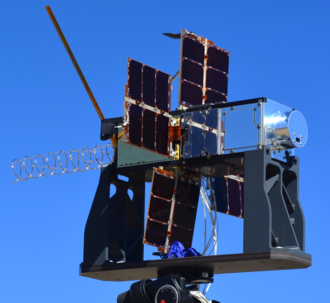 | |
| Mission type | Technology |
|---|---|
| Operator | Los Alamos National Laboratory (LANL) |
| COSPAR ID | 2022-074B |
| SATCAT no. | 52945 |
| Mission duration | 3 to 5 years |
| Spacecraft properties | |
| Manufacturer | Los Alamos National Laboratory (LANL) |
| Launch mass | 6.25 kg |
| Start of mission | |
| Launch date | 19.02.2022 |
| Orbital parameters | |
| Semi-major axis | 6586 km |
| Periapsis altitude | 205.3 km |
| Apoapsis altitude | 226.6 km |
| Inclination | 45º |
| Period | 88.7 minutes |
Nano-satellite Atmospheric Chemistry Hyperspectral Observation System (NACHOS) is an experimental 3U CubeSat created by Los Alamos National Laboratory. Its purpose is to carry out high-resolution hyperspectral photography of trace gases to assist researchers studying topics such as volcanology and climate change.
Satellites
There are a total of two satellites participating in this program: NACHOS-1 and NACHOS-2.
NACHOS-1
The first satellite of the program, NACHOS-1, a Prometheus Block-2 1.5U CubeSat featuring the attached 1.5U NACHOS experiment module was launched aboard Northrup Grumman’s 17th Cygnus (spacecraft) on February 19, 2022, from Wallops Flight Facility in Wallops Island, Virginia. The Cygnus cargo craft docked to the International Space Station, delivering over 8,000 pounds of cargo, prior to raising its orbit above that of the International Space Station to deploy the satellite. The satellite was released into low Earth orbit using a NanoRacks deployer connected to the outside of the cargo craft, prior to the craft initiating a destructive re-entry.
NACHOS-2
The NACHOS-2 satellite launched aboard a Virgin Orbit LauncherOne rocket in July 2022. This satellite has joined NACHOS-1 in orbit and will continue the mission to monitor trace gases in Earth’s atmosphere.
References
- Labs, Los Alamos National. "Using tiny satellites to monitor harmful gases from space". Discover Los Alamos National Laboratory. Retrieved 2022-07-27.
- P. Love, Steven. "NACHOS: Nano-satellite Atmospheric Chemistry Hyperspectral Observation System" (PDF). Program: InVEST-17-0013, NASA. Retrieved 4 July 2022.
- Taylor, Gage (2022-02-20). "High-Flying NASA "NACHOS" Compact Hyperspectral Imager May Help Predict Volcanic Eruptions". SciTechDaily. Retrieved 2022-10-18.
- "WMO OSCAR Details for Satellite Programme NACHOS". space.oscar.wmo.int. Retrieved 2022-07-27.
- Steve Love (2022-03-31). "Using tiny satellites to monitor harmful gases from space (op-ed)". Space.com. Retrieved 2022-07-04.
- "NASA's new "NACHOS" prototype instrument may help predicting volcanic eruptions". www.un-spider.org. 2022-02-23. Retrieved 2022-12-13.
- Gray, Ellen (2022-06-30). "Novel NASA Instrument Sets Sights on Earth-bound Solar Radiation". NASA. Retrieved 2022-07-04.
This spacecraft or satellite related article is a stub. You can help Misplaced Pages by expanding it. |